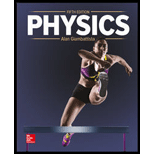
Concept explainers
(a)
The wavelengths can absorbed by the
(a)
Answer to Problem 64P
The wavelengths can absorbed by the
Explanation of Solution
Write the expression for the absorbed energy associated from the transition between the energy levels.
Here,
Write the expression for the
Here,
Write the expression for wavelength.
Here,
Use equation (II) and (I) in (III) to solve for absorbed wavelength associated from the transition between the energy levels.
Conclusion:
Substitute
Substitute
Substitute
Substitute
Therefore, the wavelengths can absorbed by the
(b)
The recoil speed of the atom after absorption.
(b)
Answer to Problem 64P
The recoil speed of the atom after absorption are
Explanation of Solution
Write the expression for the energy of the photon.
Here,
Write the expression for
Write the expression for the momentum associated with the photon.
Use equation (V) and (VI) in (VII) to solve for
Write the expression for momentum associated with hydrogen atom.
Here,
Equate equation (IX) and (VII) to solve for recoil velocity.
Conclusion:
Substitute
Substitute
Therefore, the recoil speed of the atom after absorption are
(c)
The wavelength of each photon emitted and classify its region in
(c)
Answer to Problem 64P
The wavelength of photon emitted from
Explanation of Solution
Use equation (IV) to solve for the wavelength associated with the absorbed wavelength associated from the transition between the energy levels.
Conclusion:
Substitute
Substitute
Substitute
Substitute
Substitute
Substitute
Therefore, the wavelength of photon emitted from
Want to see more full solutions like this?
Chapter 27 Solutions
Physics
- a.) Find the frequency in Hertz of radiation with energy of 2.179 x 10-18 J per photon. b.) What frequency of light would be needed to make an electron in a Hydrogen atom jump from n=1 to n=3? c.) A spectral line is measured to have a wavelenght of 1000nm. Is this within the Balmer series?arrow_forwardA hydrogen atom initially in its ground state (n = 1) absorbs a photon and ends up in the state for which n = 3. (a) What is the energy of the absorbed photon? (b) If the atom eventually returns to the ground state, what photon energies could the atom emit?arrow_forwardFor the thermal radiation from an ideal blackbody radiator with a surface temperature of 2000 K, let Ic represent the intensity per unit wavelength according to the classical expression for the spectral radiancy and IP represent the corresponding intensity per unit wavelength according to the Planck expression.What is the ratio Ic/IP for a wavelength of (a) 400 nm (at the blue end of the visible spectrum) and (b) 200 mm (in the far infrared)? (c) Does the classical expression agree with the Planck expression in the shorter wavelength range or the longer wavelength range?arrow_forward
- (a) If the average frequency emitted by a 120 W light bulb is 5.00 * 1014 Hz and 10.0% of the input power is emitted as visible light, approximately how many visible-light photons are emitted per second? (b) At what distance would this correspond to 1.00 * 1011 visible-light photons per cm2 per second if the light is emitted uniformly in all directions?arrow_forwardThe speed of an electron that is emitted from the surface of a sample of a rubidium metal by a photon is 65km/hr a) what is the kinetic energy of the ejected electron? b) the work function of rubidium is 3.50 eV. What are the frequencyand wavelength of the radiation applied to the metal?arrow_forwardWhat is the wavelength of (a) a 12-keV X-ray photon; (b) a 2.O-MeV y -ray photon?arrow_forward
 Modern PhysicsPhysicsISBN:9781111794378Author:Raymond A. Serway, Clement J. Moses, Curt A. MoyerPublisher:Cengage Learning
Modern PhysicsPhysicsISBN:9781111794378Author:Raymond A. Serway, Clement J. Moses, Curt A. MoyerPublisher:Cengage Learning Principles of Physics: A Calculus-Based TextPhysicsISBN:9781133104261Author:Raymond A. Serway, John W. JewettPublisher:Cengage Learning
Principles of Physics: A Calculus-Based TextPhysicsISBN:9781133104261Author:Raymond A. Serway, John W. JewettPublisher:Cengage Learning Physics for Scientists and Engineers with Modern ...PhysicsISBN:9781337553292Author:Raymond A. Serway, John W. JewettPublisher:Cengage Learning
Physics for Scientists and Engineers with Modern ...PhysicsISBN:9781337553292Author:Raymond A. Serway, John W. JewettPublisher:Cengage Learning University Physics Volume 3PhysicsISBN:9781938168185Author:William Moebs, Jeff SannyPublisher:OpenStax
University Physics Volume 3PhysicsISBN:9781938168185Author:William Moebs, Jeff SannyPublisher:OpenStax Glencoe Physics: Principles and Problems, Student...PhysicsISBN:9780078807213Author:Paul W. ZitzewitzPublisher:Glencoe/McGraw-Hill
Glencoe Physics: Principles and Problems, Student...PhysicsISBN:9780078807213Author:Paul W. ZitzewitzPublisher:Glencoe/McGraw-Hill Physics for Scientists and Engineers: Foundations...PhysicsISBN:9781133939146Author:Katz, Debora M.Publisher:Cengage Learning
Physics for Scientists and Engineers: Foundations...PhysicsISBN:9781133939146Author:Katz, Debora M.Publisher:Cengage Learning





